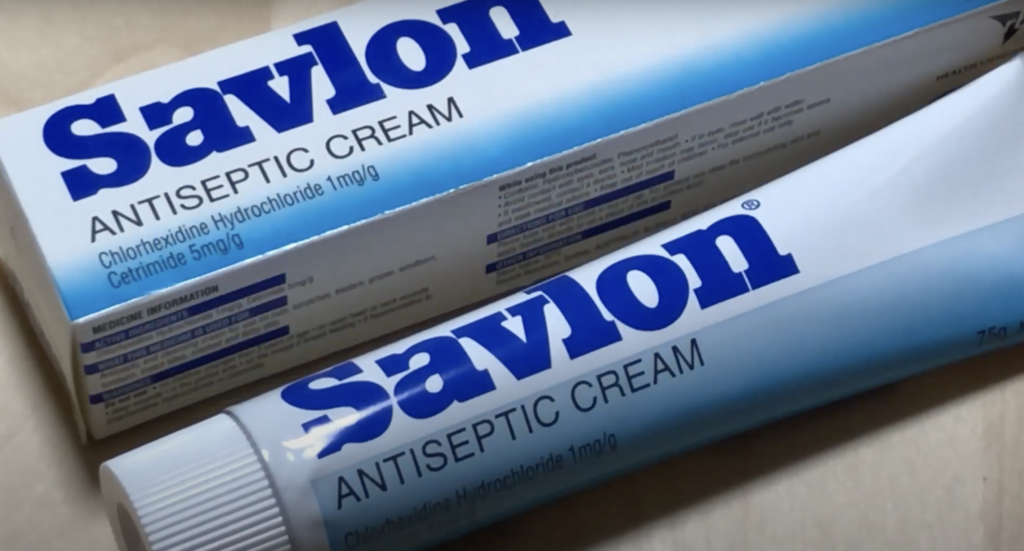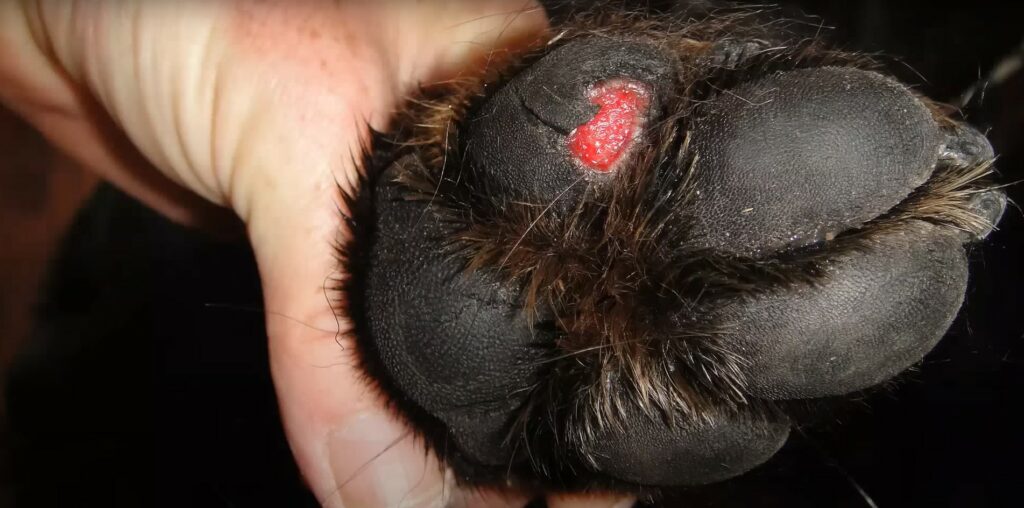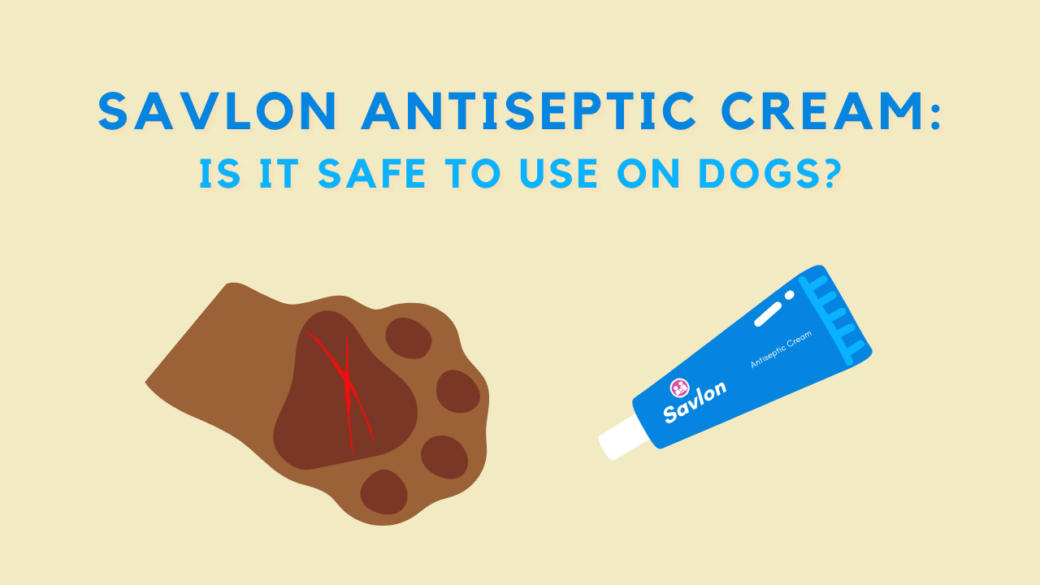When a dog has minor cuts or a wound, keeping them clean falls on the owner’s shoulders. Of course, going to the vet can be helpful, but not all grazes need to be checked by a professional; large wounds, like a bite wound, should always be looked at by a veterinarian. Antiseptic creams can help to prevent infection, and these products are very accessible, being sold in pharmacies and supermarkets around the UK.
However, not many dog owners have pet-friendly antiseptic products in the house. These usually need to be prescribed by vets. So, in that case, is it safe to use human products, like Savlon, on dogs?
Salvon is safe to use on dogs if the antiseptic cream is applied correctly. As it is a product made for specifically for human use, it can cause adverse affects when used on animals, such as gastrointestinal and skin problems. This is why is it essential to use Savlon on dogs occasionally, in small amounts, and cover the area afterward to prevent licking and ingesting the cream.
Table of Contents
What is Savlon?
Savlon is a topical medication commonly used for minor cuts and wounds in humans and can be bought from most shops, pharmacies, and online stores. The product description states that this antiseptic cream is “a first aid treatment for minor wounds and skin reactions.” It is safe to use on children as well as adults, but it should only be used externally. This does not mean it is safe to use on dogs, however.

Can You Use Savlon on Dogs?
Generally, human Savlon can be used on dogs as a one-off treatment. The cream should only be used in small quantities as it has not been formulated for use on dogs. If a large quantity is used, there is a higher risk of the dog ingesting the cream, which includes ingredients that are toxic to most dogs.
It is important to remember that a dog’s skin reacts differently to a human’s; a dog’s skin will have a different pH and sensitivities in comparison to a human’s. This means products designed for humans, like Savlon, could cause the dog to experience skin irritation and other adverse reactions. Before applying Savlon on dogs, it is best to use caution.
If you believe your dog requires an antiseptic cream, it is best to contact your local vet for advice first. The vet will be able to advise how to apply Savlon and even prescribe an antiseptic cream specifically designed for dogs.
Can You Use Savlon on Dogs’ Skin?
If your dog has minor wounds or scrapes that do not require veterinary attention, Savlon can be used to prevent infection and encourage healing. It should only be used on the affected area in small amounts, though.
A bandage should then be used to cover the wounded area, preventing the dog from licking and ingesting the Savlon. Some ingredients in this antiseptic cream can be toxic to dogs when ingested.
Can You Use Savlon on Dogs’ Paws?
Savlon can be used on a dog’s paws. If your dog has an open wound on its paw, such as a ripped claw or cut paw pad, then Savlon can be applied once the wound has been cleaned and then covered with a bandage or similar fabric.
Can You Use Savlon in Dogs’ Ears?
As Savlon is only safe for external use, using the cream inside a dog’s ears should be avoided, although it can be used on the outer part of the dog’s ears. As a general rule, do not use Savlon on sensitive areas like the eyes, mouth, nose, and inside ears.
Are There Antiseptic Creams for Dogs?
There are several dog creams available that will effectively treat skin conditions and cuts, and these have been formulated for dogs, which means they are much safer to use on dogs than other creams made for human use, like Savlon. If your dog is suffering from irritated skin, a minor wound, or something similar, it is advised to contact the vet for assistance.
When are Antiseptic Creams Used on Dogs?
Savlon and other antiseptic creams can be used to treat minor pet wounds, such as:
- Allergic reactions
- Bee or wasp stings
- Cuts and scrapes
- Infections
- Insect bites

However, Savlon should only be used on dogs as a one-off. If the animal requires regular applications of antiseptic, then a dog-safe cream should be used.
How to Use Savlon Antiseptic Cream on Dogs
Before applying the antiseptic cream to the dog, the dog’s skin or wound must first be cleaned. To do this, mix warm water with either Hibiscrub or sea salt; if using Hibiscrub, the correct ratio should be ten parts water to one part Hibiscrub. The Hibiscrub-water or salt water mixture can then be cooled and used to wash the dog’s wound or skin.
After drying the dog’s skin with a clean towel, the antiseptic cream can be applied to the affected area. If using a human antiseptic cream like Savlon, it is essential you apply a small amount only. For dog-safe antiseptic creams, be sure to follow the instructions on the packaging or the vet’s advice. The cream should be used to cover the area before it is lightly rubbed into the skin.
Once the antiseptic cream has been massaged into the dog’s skin, use a bandage or dressing over the area to stop the dog from licking it. A first aid kit will likely contain the gauze required.
Ingredients in Savlon
The two active ingredients in Savlon are cetrimide and chlorhexidine gluconate, which work to stop bacteria growth.
- Cetrimide, which is a mixture of three quaternary ammonium compounds, has antiseptic properties and is used in topical creams and solutions to prevent and treat infections.
- Chlorhexidine gluconate is commonly found in antiseptics and disinfectants, used to treat bacterial infections, and can also be used in mouthwashes.
If ingested by dogs or humans, these ingredients can be harmful.
What to Do if Your Dog Licks Savlon
Dogs tend to lick open wounds during the healing process, but this can be harmful, especially when a potentially harmful solution has been applied to the area. When applying Savlon on dogs, it is essential that the ointment is not applied in large quantities, that the dog is monitored after, and the affected area is covered with a clean bandage to prevent licking.
However, if your dog does lick the antiseptic cream, it might begin displaying symptoms such as diarrhoea, lethargy, vomiting, and weakness. These symptoms are usually caused by the toxicity of ingredients in the antiseptic cream.
If the dog does begin showing these signs, contact the vet immediately.
What are the Signs of Toxicity Caused by Savlon?
As previously mentioned, Savlon can have adverse effects if ingested. However, these are not the only symptoms that this antiseptic cream can cause dogs to experience. An overview of the toxicity symptoms has been provided below:
- Gastrointestinal issues: If a dog ingests Savlon, it can suffer from diarrhoea, gastric irritation and ulcerations, and vomiting.
- Lethargy: Again, if ingested, the antiseptic cream can cause dogs to seem lethargic and weak.
- Skin irritation: When applied to a dog’s skin, Savlon can cause dryness, redness, swelling, and other dermatological problems.
- Breathing difficulties: Although rare, Savlon can cause dogs to experience coughing, difficulty breathing, and wheezing in severe cases.
- Seizures: Savlon can also cause dogs to take seizures in extreme cases.
If your dog displays any of these symptoms, it is crucial you seek veterinary advice as soon as possible.
How Will the Vet Treat Savlon Poisoning in Dogs?
Once ingested, Savlon basically acts like a poison in the dog’s body, similar to grape or raisin consumption, and immediate veterinary attention is required. Treatments used on dogs that have ingested Savlon include inducing vomiting, administering activated charcoal, giving IV fluids, and/or prescribing other medications.
Should an Antiseptic Cream Be Included in a Dog First Aid Kit?
Having a first aid kit for your pet dog is a handy idea; it means everything you might need is available when required. Antiseptic wipes and creams specifically for dogs can be kept in pet first aid kits; any medication that is still in date and has been prescribed by a veterinary professional should be included, too.
Other items to include in a first aid kit for dogs are:
- Bandages, including self-adhesive and open-weave varieties
- Cotton wool
- Curved scissors
- Dressings that are absorbent and non-adhesive
- Sterile gauze
- Surgical sticky tape
To Sum Up
Although Savlon should not be regularly used as an antiseptic for dogs, there are certain circumstances in which the cream can be used. It is critical that dog owners understand when Savlon can and cannot be used on dogs; it should only be used occasionally and in small quantities, and it should not be used on sensitive areas, like on the eyes, nose, mouth, or inner ears. Not following these guidelines could harm the dog.
Due to its ingredients, Savlon can be toxic to both humans and dogs, but dogs do not understand they cannot consume this ointment. If they do lick the antiseptic cream, it could cause gastrointestinal issues, skin irritation, and other health problems. This is why it is essential to be cautious when using the cream and ensure the affected area is covered after it has been applied.
Therefore, Savlon can be safe to use on dogs if used correctly.
Disclaimer: This article is for informational purposes only and should not be used as a substitute for professional veterinary advice.

